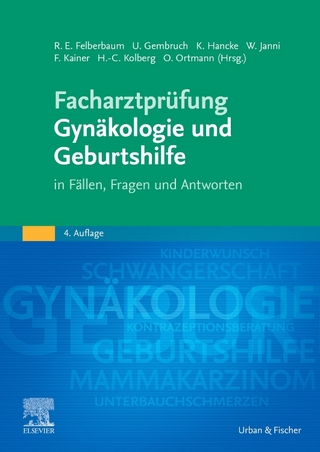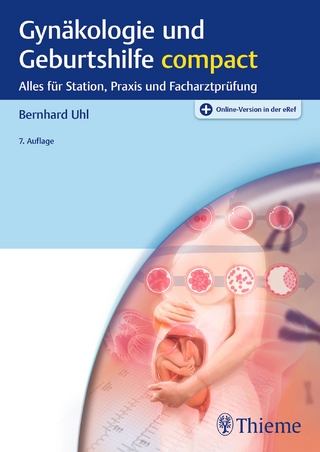
Fetal and Neonatal Brain Injury
Cambridge University Press (Verlag)
978-1-107-11080-9 (ISBN)
Improvements in the detection of fetal and neonatal brain injuries, advances in our understanding of the pathophysiology, cellular and molecular bases of encephalopathy, and new treatment options have all combined to produce significant changes in the management of neonatal brain disorders in the past few years. This new edition of Fetal and Neonatal Brain Injury brings the reader fully up to date with all advances in clinical management and outcome assessment. Updated material includes inflammation focusing in particular on chorioamnionitis and fetal brain injury; genetic brain injury; and expanded sections on cholestasis, diabetes, and thyroid disease. An updated, highly illustrated chapter on structural and functional imaging of the fetal and neonatal brain is also included. An outstanding international team of highly experienced neonatologists and maternal-fetal medicine clinicians have produced a practical, authoritative clinical text that gives clear management advice to all clinicians involved in the treatment of these patients.
David K. Stevenson is the Harold K. Faber Professor of Pediatrics and has held numerous leadership roles at Stanford University School of Medicine, California. He is currently the Senior Associate Dean for Maternal and Child Health, the Director of the Charles B. and Ann L. Johnson Center for Pregnancy and Newborn Services, the Co-Director of the Stanford Child Health Research Institute, and the Leader of Spectrum Child Health at Stanford University. Dr Stevenson has received many awards, including the Virginia Apgar Award, which is the highest award in Perinatal Pediatrics, and the Jonas Salk Award for Leadership in Prematurity Prevention from the March of Dimes Foundation. In recognition of his achievements, Dr Stevenson is a member of the National Academy of Medicine. He has served as the President of the American Pediatric Society and was co-founder of the California Association of Neonatologists (CAN) and the California Perinatal Quality Care Collaborative (CPQCC). Dr Stevenson has published over 540 articles on a wide range of scientific topics in neonatal-perinatal medicine. He is also the editor of several other textbooks, including the first edition of Neonatology: Clinical Practice and Procedures (2015), and numerous chapters in most of the major textbooks on neonatology. William E. Benitz is a clinical investigator whose work centers on evidence assessment and decision analysis. Much of his work has related to early diagnosis, management, and prevention of neonatal infections, including a definitive assessment of C-reactive protein measurements in management of neonates with suspected sepsis and a decision analysis supporting recommendations for prevention of early-onset group B streptococcal sepsis. Other projects include evaluations of the efficacy of surfactant in congenital diaphragmatic hernia, the role of ancillary tests in diagnosis of candidal sepsis, and analyses of rapid tests for maternal group B streptococcal colonization. His analysis showing that routine early treatment to close the persistently patent ductus arteriosus in preterm infants does not improve outcomes for those infants has changed practice worldwide. The unifying thread within these studies is rigorous application of quantitative methods to assessment of evidence for practice, informed by an intimate familiarity with the practice of neonatal medicine, outstanding clinical expertise, and a well-honed habit of critical thinking. Dr Benitz has served as member and chair of the American Board of Pediatrics Sub-Board of Neonatal-Perinatal Medicine and on the American Academy of Pediatrics Committee on Drugs and Committee on the Fetus and Newborn. Philip Sunshine's primary interests are in the areas of neonatal nutrition and developmental gastroenterology. The use of parenteral nutrition in very low birth weight infants, and the introduction of early enteral feeding to stimulate gastrointestinal maturation are specific areas of his investigative endeavors. In a career that has spanned over five decades, Dr Sunshine has authored numerous important publications, including those describing how lactose malabsorption can result from acute gastroenteritis, published in Pediatrics in 1964, fundamental contributions on intestinal disaccharides in an early report in Science, also in 1964. In another seminal paper, Dr Sunshine, along with his mentor, Norman Kretchmer, and Otakar Koldosky, described the cellular migration of intestinal epithelial cells in suckling and weaned rats. This Nature paper was the first to show that newborns had delayed cellular migration, effecting their capacity to recover from injury and digest disaccharidases. Dr Sunshine has received numerous honors throughout his career, including the Virginia Apgar Award in 2001. He is a member of many professional societies, including the American Pediatric Society. He served as Editor of the Neonatal-Perinatal Medicine exam from 1981 to 2001. Susan R. Hintz, M.D., MS joined the Stanford University School of Medicine faculty in 2000 as Assistant Professor and was named the inaugural Robert L. Hess Family Endowed Professor in 2014. Dr Hintz is Associate Chief for Prenatal Services in the Division of Neonatal and Developmental Medicine, and co-Director for the Johnson Center for Pregnancy and Newborn Services at Lucile Packard Children's Hospital Stanford. Dr Hintz is a neonatologist and perinatal epidemiologist, whose investigative work focuses on understanding and improving morbidity and neurodevelopmental outcomes for extremely premature and high-risk infants, including the use of neuroimaging as a biomarker. Hintz serves as a principal investigator for neurodevelopmental follow-up in the Eunice Kennedy Shriver NICHD Neonatal Research Network. She is a leader in the CPQCC – CCS High-Risk Infant Follow-Up Initiative, spearheading creation of a California statewide framework for quality improvement processes from NICU discharge through early childhood. Dr Hintz also led the creation of the The Fetal and Pregnancy Health Program at Lucile Packard Children's Hospital Stanford, and has served as Medical Director from its inception. The program has established a multidisciplinary and highly integrated approach to comprehensive care for complex fetal patients, mothers, and families. Maurice L. Druzin, M.D. is Professor of Obstetrics and Gynecology at Stanford University School of Medicine and Vice Chair of the Department of Obstetrics and Gynecology at Stanford. Dr Druzin completed his medical school training at the University of Witwaterstrand in Johannesburg, South Africa. and residency training in Obstetrics and Gynecology at the University of Colorado Medical Center Affiliated Hospitals. Following fellowship in Maternal-Fetal Medicine at the University of Southern California, he was appointed Chief of the Division of Maternal-Fetal Medicine and Professor of Obstetrics and Gynecology at Cornell University Medical College from 1980–1991. In 1991, Dr Druzin was appointed Professor of Obstetrics and Gynecology and Chief, Division of Maternal Fetal Medicine and Obstetrics at Stanford University and Lucile Packard Children's Hospital. Dr Druzin's focus is in fetal assessment and medical complications of pregnancy. He served on the American College of Obstetricians and Gynecologists Hypertension in Pregnancy Taskforce which published national guidelines in 2013. He is a member of the California Maternal Quality Care Collaborative (CMQCC) which published nationally recognized 'toolkits' on hemorrhage and preeclampsia. He serves on the California Pregnancy – Associated Mortality Review Committee (PAMR) which determines the causes of maternal mortality, and recommends preventative strategies.
Part I. Epidemiology, Pathophysiology, and Pathogenesis of Fetal and Neonatal Brain Injury: 1. Neonatal encephalopathy: epidemiology and overview; 2. Neuronal cell death mechanisms relevant to humans: rethinking modeling neonatal hypoxic-ischemic encephalopathy; 3. Cellular and molecular biology of hypoxic-ischemic encephalopathy; 4. The pathogenesis of preterm brain injury; Part II. Pregnancy, Labor, and Delivery Complications Causing Brain Injury: 5. Prematurity and complications of labor and delivery; 6. Risks and complications of multiple gestation; 7. Intrauterine growth restriction; 8. Maternal diseases that affect fetal and neonatal neurodevelopment; 9. Obstetrical conditions and practices that affect the fetus and newborn; 10. Fetal and neonatal injury as a consequence of maternal substance abuse; 11. Hypertensive disorders of pregnancy; 12. Complications of labour and delivery; 13. Fetal responses to asphyxia; 14. Antepartum evaluation of fetal well-being; 15. Intrapartum evaluation of the fetus; Part III. Diagnosis of the Infant with Brain Injury: 16. Clinical manifestations of hypoxic-ischemic encephalopathy; 17. The use of EEG and aEEG in assessing the term and preterm brain; 18. Neuroimaging in the evaluation of pattern and timing of fetal and neonatal brain abnormalities; 19. Light-based assessment of the brain; 20. Placental pathology and the etiology of fetal and neonatal brain injury; 21. Timing perinatal hypoxic-ischemic brain injury; Part IV. Specific Conditions Associated with Fetal and Neonatal Brain Injury: 22. Congenital malformations of the brain; 23. Neurogenetic disorders of the brain; 24. Hemorrhagic lesions of the central nervous system; 25. Neonatal stroke; 26. Neurodevelopmental consequences of neonatal hypoglycemia; 27. Hyperbilirubinemia and kernicterus; 28. Polycythemia and fetal–maternal bleeding; 29. Hydrops fetalis; 30. Bacterial sepsis in the neonate; 31. Neonatal bacterial meningitis; 32. Neurological sequelae of congenital and perinatal infections; 33. Neurological complications of perinatal human immunodeficiency virus infection; 34. Inborn errors of metabolism and single gene disorders with features of neonatal encephalopathy; 35. Acidosis and alkalosis; 36. Persistent pulmonary hypertension of the newborn; 37. Pediatric cardiac surgery: relevance to fetal and neonatal brain injury; 38. Neonatal resuscitation: immediate management; 39. Improving performance, reducing error, and minimizing risk in the delivery room; 40. Extended management following resuscitation; 41. Endogenous and exogenous neuroprotective mechanisms after hypoxic-ischemic injury; 42. Neonatal seizures: evaluation, treatment, and prognosis; 43. Nutritional support of the asphyxiated infant; 44. Early outcomes after extremely preterm birth; 45. Cerebral palsy: advances in definition, classification, management and outcome; 46. Neurodevelopmental and neurobehavioral outcomes of prematurity: cognition, language, academic skills, and behavioral and emotional profiles; 47. Neurocognitive outcomes in term infants with neonatal encephalopathy; 48. Neonatal neuroethics; 49. Medicolegal issues in perinatal brain injury.
| Erscheinungsdatum | 27.01.2017 |
|---|---|
| Zusatzinfo | 117 Tables, black and white; 7 Halftones, color; 84 Halftones, black and white; 29 Line drawings, color; 45 Line drawings, black and white |
| Verlagsort | Cambridge |
| Sprache | englisch |
| Maße | 193 x 253 mm |
| Gewicht | 1960 g |
| Themenwelt | Medizin / Pharmazie ► Medizinische Fachgebiete ► Gynäkologie / Geburtshilfe |
| Medizin / Pharmazie ► Medizinische Fachgebiete ► Neurologie | |
| ISBN-10 | 1-107-11080-7 / 1107110807 |
| ISBN-13 | 978-1-107-11080-9 / 9781107110809 |
| Zustand | Neuware |
| Haben Sie eine Frage zum Produkt? |
aus dem Bereich


